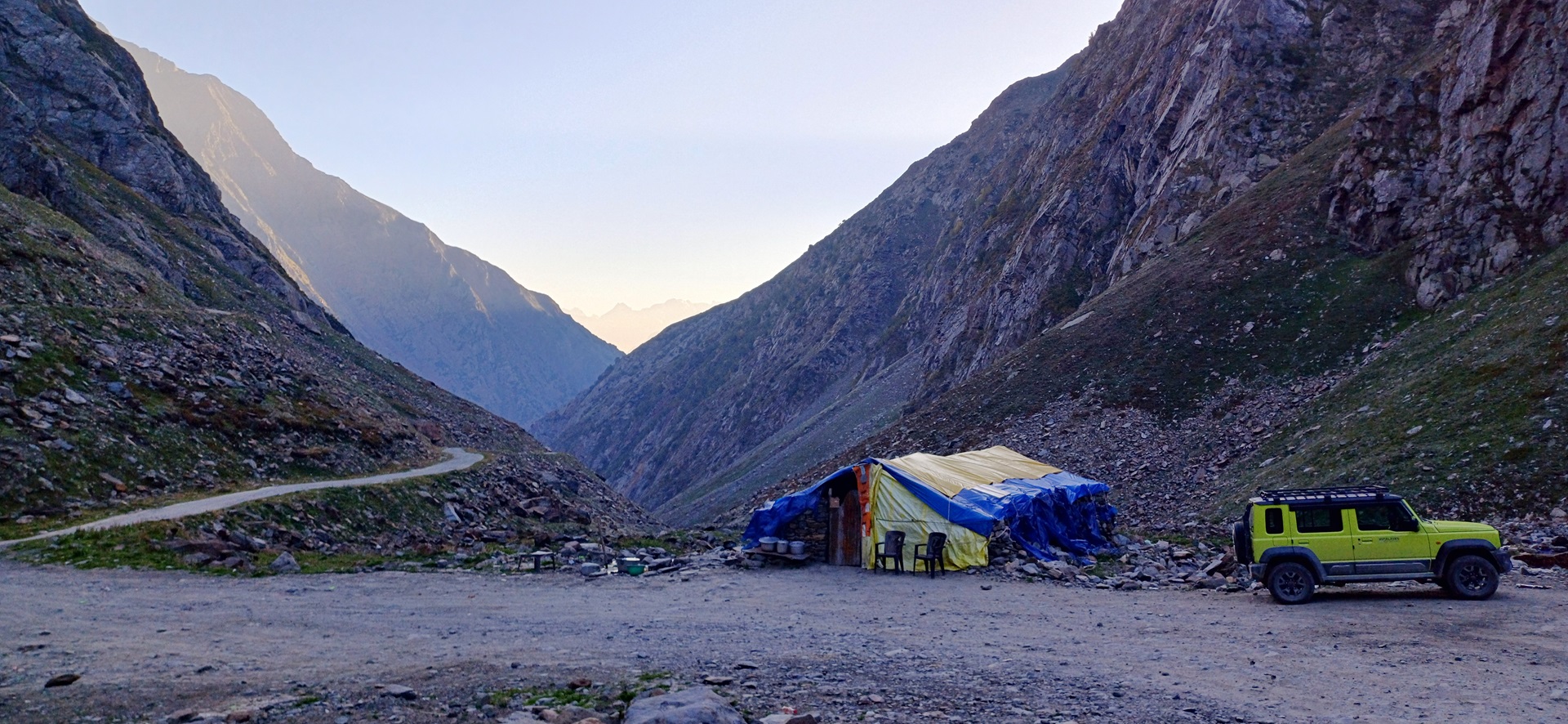A Cup of Chai
By Gaurav, Managing Partner, Himalayan Ecotourism
As I navigated the chaotic streets of Delhi, clutching a cup of unremarkable chai, my mind drifted back to the serene landscapes and the hospitality of the locals of Pangi valley. I remembered Santosh’s humble dhaba, nestled in the heart of the Sach Pass, where the air was crisp and the warmth of the people was palpable.
I have been to Ladakh thrice in the past 3 years. Every time we started from Himachal, we stocked snacks and fuel for the route. We prepared ourselves for treacherous roads and any uncertain stops we may have to take incase of road closures. Luckily, we have never been stuck anywhere except for the time when we had to stop once before Rumtse, although there was no inconvenience as we found a nice restaurant and room to stay.
Keeping extra fuel and some snacks had to be a must when heading for a recce to the Pangi valley. Something we did not do. We started our trip from the Tirthan Valley with the first night at Sissu. We wanted to have a nice home cooked meal at the homestay, but settled for a not so remarkable chicken meal. The next day as we made way through Udaipur, we could not find a place for breakfast. We were a bit late and looked like most dhaba owners had left for their fields. We managed to find a restaurant full of flies that served us an ice cold omlette after waiting for 45 minutes. I felt as if the cook prepared the omlette and let it cool before he served it to us. I wonder why !
As we continued, we realized we had to keep tab on our fuel. We did have enough for the set plan of the recce, but a detour to explore newer valleys in the region would need a thorough thought. Enroute we came across a huuugggeeee spruce tree in the middle of the road. We just couldn’t stop ourselves from getting down and hugging it! Continuing further, we realized we were not going to find a decent restaurant for lunch. The road that leads from Udaipur towards the valleys in Pangi region is quiet treacherous. A narrow rough road that will bring chill to the bones, rugged mountain on one side and the Chenab river flowing a 1000 metres deep on the other side. We did stop a few times at the edges careful not to slip and roll down a km to dip in the Chenab. We came across streams that flowed down the mountain and covered the edge of the road like a curtain, these falls did wash our dusty car well.
We stopped for lunch somewhere around Purthi, where we had momos. They were definitely much tastier than the chicken and omlette we had for our previous meals. In the back drop was the beautiful view of the Dumgol Peak at 5969m. It was a remote setting and yet one of the locals had managed to establish a beer shoppe in the middle of nowhere. Ofcourse, we did not drink and drive. We watched the chicken drinking surf excel water that had pooled up from the washing of clothes. You may probably eat one of these chickens after you head on this route.
We visited the Tuwan valley, a beautiful unexplored territory that is a perfect destination for travelers seeking offbeat experience combined with local food, dense forests and serene day hikes. There was a landslide enroute that stopped us from reaching the last village of the Tuwan valley and we decided to head towards Killar. It got quiet dark by the time we made it to the main road and we stopped at Phindru. We found a cozy homestay with basic amenities and a mind-blowing meal. It was late and the host said they could just cook rice and dal for us. We freshened up and headed to their kitchen where they served us rice, rotis, rajma and a mushroom mix vegetable. Having such a delicious meal after 2 days of bland food was a joy to the soul.
The next day we headed to Sural valley, the main purpose of our recce was to explore treks in this valley. We purchased 10 litres of fuel from a local vendor to be on the safer side. The beauty of the valley cannot be described in words. We just had enough time to reach the end of the valley and hike to a beautiful waterfall. The surrounding was lush with autumn colors. We had pears for lunch as the houses in the village were empty. All the villagers were busy on the farms with harvesting. The Sural valley offers a mesmerizing view of the Sersank Peak at 6100m. You will also come across gompas and buddhist culture in the villages that lie at the end of these valleys.
Around 3 PM, we started the engine and decided to reach as further as we could towards Dalhousie. Enroute the Sach Pass, the road got worse slowing us down. We stopped to climb a walnut tree only to have made a fool of ourselves trying to find walnuts in the wild chestnut. The road to the Sach Pass is breath taking with its forests and gorges. The ice caps have formed huge cave like structures beneath which the river flows as white as milk. It was getting dark and we came across forest patrol who advised us to stop at a dhaba as the weather was about to get worse. We reached a dhaba around 8 PM, I was expecting an establishment like Ladakh where we would have a small room with a attached/separate bathroom. I entered and asked, “SK Dhaba?” One of the two guys said “Haan ji yahin hai, aao khana khao” (Yes, come in, have food). That was Santosh. It was cold, I ordered chai for myself and Stephan, and went back to the car to grab my jacket. I wasn’t expecting much, I was just hoping for the chai not to be watery. I took a sip and what a bliss! I smiled at Santosh and expressed gratitude for the perfect adrak chai he made. Santosh said it is almost the end of the season and we will be winding up business for the year in a few days as there will be metres of snow here soon. We had pears and cucmbers for starters to go with a glass of local chang. Throughout the conversation, Santosh and Ramesh emphasized on the hospitality of the locals towards the guests. For them guests were like god “atithi devo bhava” in the true sense. Both of them said, “as we can recall, it is the first time we have had such a lovely conversation with outsiders over the last couple of years” They served us a delicious meal and made room for us to sleep. It was 9 PM when we finished dinner and another car with tourists arrived asking for the route ahead. Santosh recommended them to stay for the night as both the road and the weather was bad, he offered them free accommodation. The over confident tourists decided to drive anyway and left. While I was glad that we made this stop and had the opportunity to share a meal over a lovely conversation.
Santosh said that the primary purpose of establishing the dhaba was to provide shelter and food for the locals who transported vegetables to Chamba. These villagers would sometime drive at very odd hours and needed a base before the pass at occasions when weather would restrict further ascend. Santosh and Ramesh are always ready to serve food to travelers no matter what time of the day or night it is. The locals have deep respect for Birbhadra Singh, the political leader who has contributed a lot for the development and the sustenance of the communities in Pangi valley.
As long as you are not concerned about a comfortable bed, Santosh’s dhaba is a hotspot for stargazing. Inspite of the cold, I stood outside the dhaba for almost an hour gazing at the milkyway. Spending a night or two at the dhaba will definitely enhance the experience of travelers on this route. They also have tents they can pitch for you at a reasonable cost.
In Delhi, the fast-paced lifestyle seemed to suffocate the city’s cultural roots. Tradition and heritage felt like distant memories, lost in the relentless pursuit of progress. But Santosh’s dhaba is where stories are created, every single day of the year he runs the dhaba.
Santosh’s dhaba was more than just a eating joint; it was a symbol of resilience and community spirit. His dedication to preserving cultural traditions was inspiring, and his words still resonated in my mind: “The gods and goddesses are an integral part of our lifestyle, and we strive to keep our culture alive.”
As I reflected on my journey, I realized that rural India’s connection to its heritage was rooted in its connection to the land, community, and tradition. The slower pace of life allowed for a deeper appreciation of cultural traditions, and the proximity to nature and communal living fostered a strong sense of cultural identity.
Then there was Santosh’s uncle, a devout priest at the Sach Pass Goddesses’ temple, who began his day with a disciplined routine. His conviction to uphold the legacy of his ancestors was unwavering, and his story of Nag Devta, the mystical snake god, left us intrigued. The priest wakes up every morning at 7. With temperatures close to sub zero, he takes a cold water shower and waits for a ride to reach the temple at the top. On days when he does not find a ride, he walks 11 km to the Sach Pass at 4500m. Today he will ride with us. it was cold and we did not want to get out of our blankets, but we were motivated to ensure he reaches the temple in time to start his worship. Just before the pass we stopped at the Bhoot ground. The priest pointed at a huge black rock, roughly the size of a rhino. The locals believe the rock to be Nag devta, a snake god who shifts positions multiple times throughout the day. We reached the top, took blessings of the Goddess and continued our return journey.
As I finished my city-bought chai, now cold and uninviting, I yearned for the authentic flavors and experiences that awaited in the uncharted territories of rural India. As I looked out at the cityscape, I knew that there were countless stories like Santosh’s, waiting to be discovered – stories of resilience, community, and cultural pride.
I look forward to visiting the Bhoot ground next year to check if the Nag Devta has shifted and probably for a new story.







